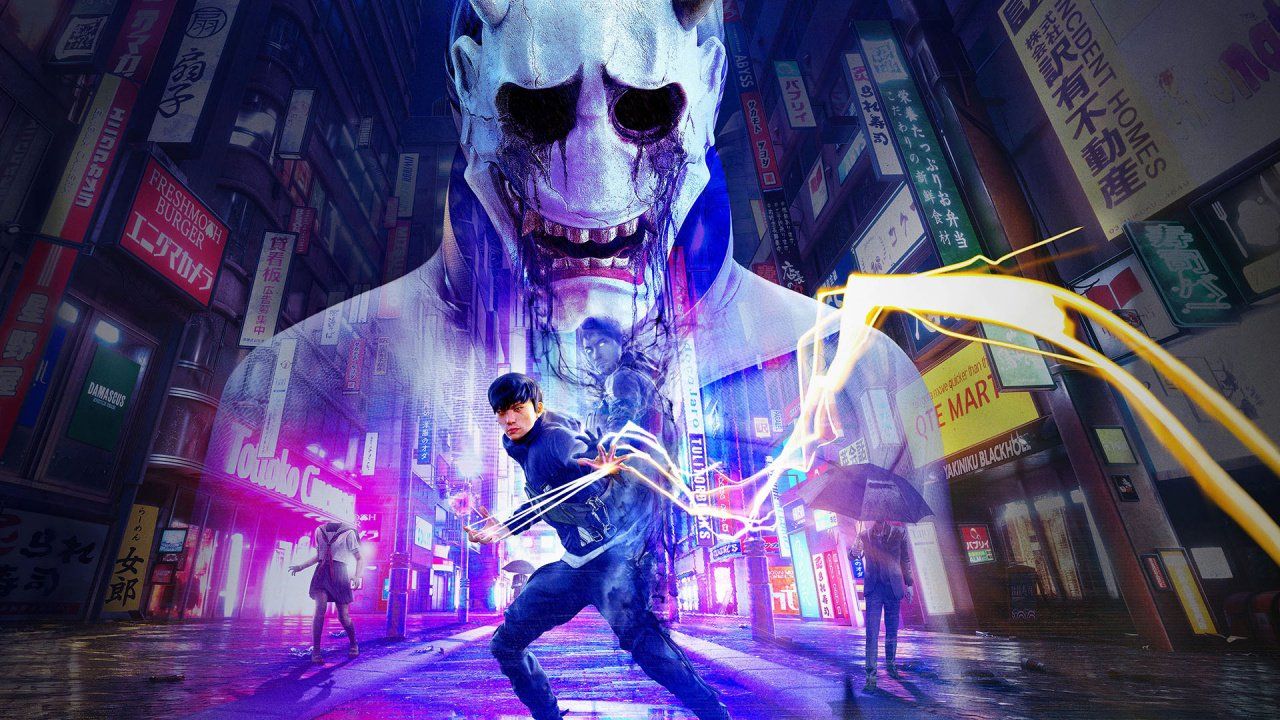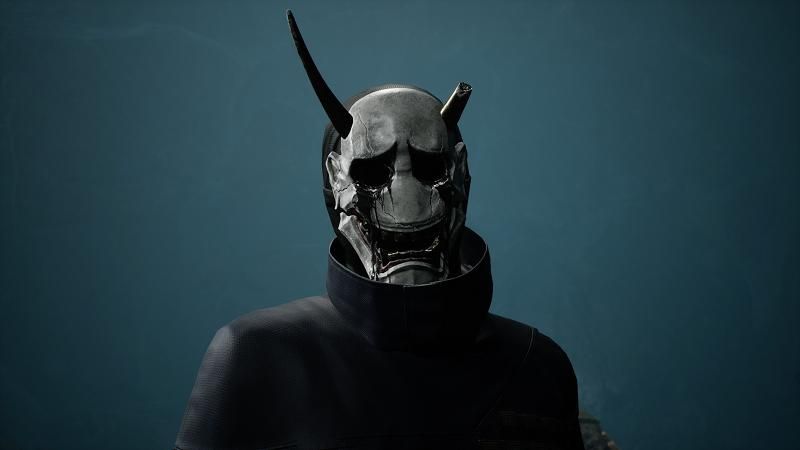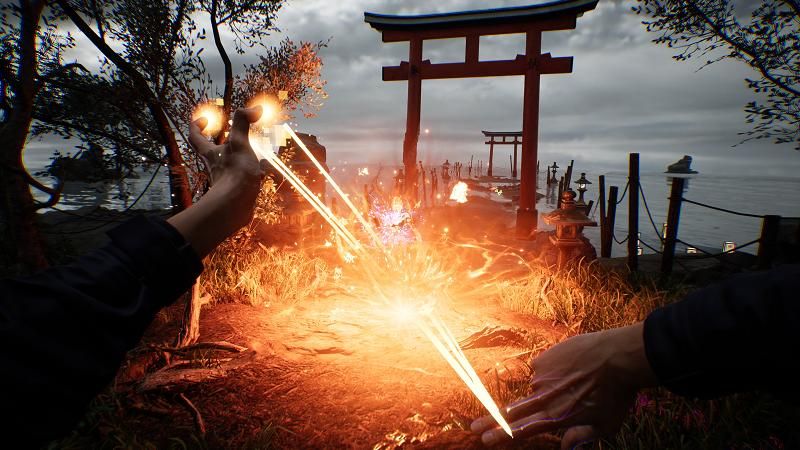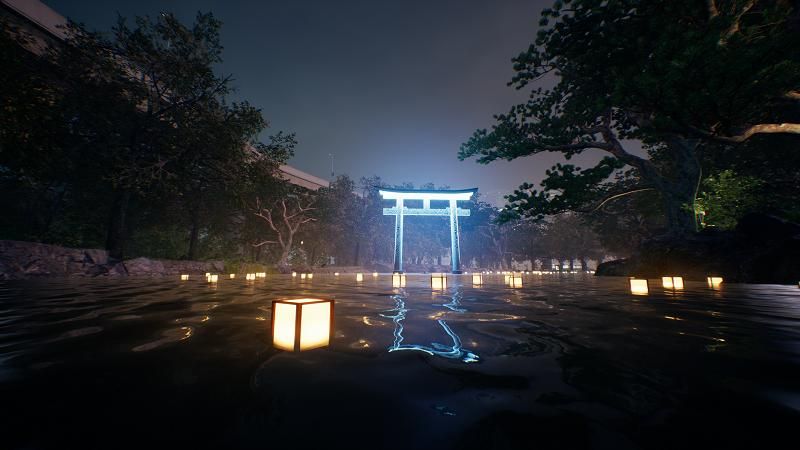A Straightforward Story
The story of Ghostwire: Tokyo is fairly straightforward. Akito, the story's protagonist, finds himself possessed by a spirit in Tokyo where everyone, except animals, has disappeared. To make things worse, you have spirits or visitors roaming the streets that are creepy enough to scare the hell out of you. Interestingly, you'll see around ten types of unique visitors throughout the gameplay.
Conveniently enough, KK, the spirit possessing Akito, gives him psychic abilities to survive and fight against the dangers. Also, as you progress in the game, you'll come across a group of people wearing hannya masks who are commanding these visitors.
The game doesn't spend any time explaining anything about Akito or KK, and you straight away start fighting the visitors with these newfound powers. You know nothing about Akito except the fact that he has someone he wants to save. Honestly, I would have loved to learn something more about Akito besides his name in the beginning act.
Ghostwire: Tokyo's Story grabs your attention in the Final Act.
Similarly, you know absolutely zero aspects regarding KK and the antagonist, who has unleashed this curse on Tokyo. Unfortunately, this doesn't change until the last two-three acts, and for that reason, I couldn't connect to the main characters of the story. Personally, I lost interest in all characters and stuck with the game for its incredible gameplay.
However, it's worth pointing out that the last act of the Ghostwire: Tokyo does dive into the relationship between Akito and the person he wants to save. And that was the only point where the game grabbed my attention because of its narrative.
In terms of the story, the concluding chapter is finally a winner. From its music to voice acting and visuals, everything was on point. Moreover, it wasn't a cutscene where you are just sitting back and watching the story unfold. You'll be in control of the character in that sequence, and as you move forward, you'll feel like you are reaching the end of the road.
A Gameplay that stays with you
Ghostwire: Tokyo is definitely a winner in terms of gameplay. KK's psychic abilities allow Akito to master three elements; Wind, Water, and Fire. What's fascinating is that using these abilities to attack enemies made me feel like I was playing a shooter game.
Akito unleashes all attacks using hand gestures; the basic Wind ability has the longest range, but it does the least damage. Water ability, on the other hand, does greater damage when triggered from a close range, similar to how a shotgun works. Finally, the Fire element does the most significant damage, killing the regular Visitors in one direct hit. I personally saved the Fire element for the powerful Visitors and for Boss fights.
To take down the Visitors or bosses, you have to keep hitting them until their core or heart is exposed. Then, you can perform the most satisfying move in Ghostwire: Tokyo, ripping out enemies' cores with an electric thread. Honestly, destroying Visitors' hearts is something I never got bored of, even after performing the move multiple times.
Of course, you have to collect crystallized Ether to refill your ammo, and fortunately, I never found it challenging to find the source. Even during the boss fights, you see enough crystallized Ether to get you through the fight. However, you have to switch to a different element when you run out of a certain ability. Honestly, it would have been better if the element switch happened automatically whenever you ran out of ammo. It really frustrated me having to manually switch from one element to another during intense fights.
Apart from the three elements, Akito also gets a bow and arrow that can be used to take down enemies from a distance. Talking about stealth, you can get behind an enemy to perform a Quick Purge, without attracting any unwanted attention. Stealth is especially essential when KK and Akito are separated, and Akito can't use any elemental powers.
Besides Ether, you can also collect Meika through yellow ether crystals, which you can use to buy different Talismans. In the game, you are provided with four types of Talismans: Stun (Stops enemy from moving for a few seconds), Thicket (Obstruct enemy's vision), Exposure (Reveals Visitors' cores), and Decoy (creates a sound to distract visitors). For me, Talismans made the gameplay a lot more fun. For instance, I always found the Stun Talisman useful against a powerful visitor like Kuchisake. On the other hand, Decoy Talisman was helpful if I wanted to avoid a big group of Visitors.
Ghostwire: Tokyo's gameplay doesn't stop surprising you with its gripping elements and eccentric combat.
Ghostwire: Tokyo lets you upgrade your skills by earning Skill Points or Magatama. Players can also increase their SP, which is required to perform Ethernal Weaving, by praying to Jizo statues and making offerings. Also, once you've extracted enough cores, you can enter the Wire-In mode, which takes your SP to maximum, and your movement becomes faster.
Besides the main story, there are several side missions in Ghostwire: Tokyo. Every side-mission I tried felt completely unique and featured a new side of the supernatural. Also, by doing side missions, I explored some hidden parts of Tokyo, which made the game a lot more interesting.
Each boss fight in Ghostwire: Tokyo feels different, except for one or two attacks that stay similar with every boss. You have to take your time and learn how to counter each boss' attacks. However, each time I died in a boss fight, the game didn't take me back directly in front of the boss. Instead, I was thrown back before the cut scene that led up to the boss. So, I was really frustrated that I had to skip the cut scene in every attempt, which is something that, in my opinion, needs fixing.
Nevertheless, despite a few hiccups, I couldn't ask for more in terms of gameplay. With the wide variety of abilities, I could think of different unique ways of dominating the enemy. There wasn't even a single moment where I felt like I was losing interest in the game or the gameplay was getting repetitive or boring.
An Immersive yet Haunting Environment
Besides gameplay, my biggest takeaway from Ghostwire: Tokyo is its visuals and environment. Tango Gameworks certainly did a great job bringing Tokyo to life. When you start off in the game, only a tiny portion of Tokyo is accessible, and most parts are covered in deadly fog that eats away your health. However, you can expand the map by cleansing the Tori gates.
Every part of Tokyo in Ghostwire: Tokyo feels lifelike, and I loved exploring different streets or buildings if only to appreciate the detailing. Apart from streets, I also explored the verticality of Tokyo by getting to buildings' rooftops.
Ghostowire: Tokyo's immersive world is absolutely breathtaking.
There were several instances when the game surprised me by its distorted reality. I was absolutely mesmerized by the sequence when objects and buildings were taking different shapes and forms, and Akito was moving through those distortions. Dead Tokyo streets with vibrant lighting and music give you an apocalyptic feel. Also, the incredible music from Masatoshi Yanagi adds to the city's beauty and mystery in Ghostwire: Tokyo.
I enjoyed my time with Ghostwire: Tokyo, and I would like to spend a few more hours in the game. Even though much of the story didn't click with me, I would still go back for its satisfying gameplay and complete every side mission to explore the unknown.




